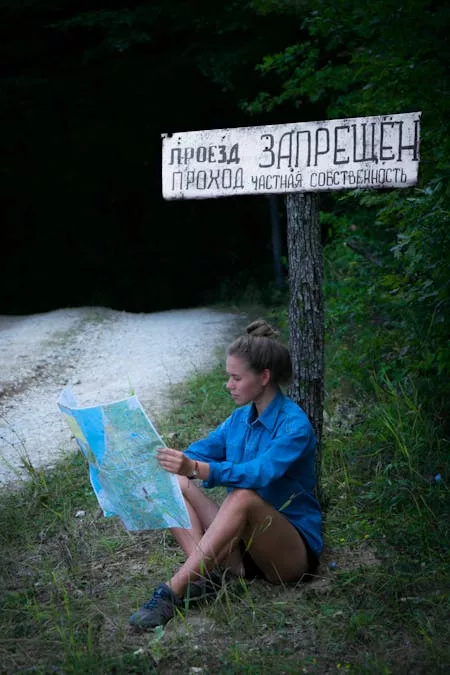
If you love hiking, learning to read a topographical map (topo map) is one of the most valuable skills you can develop. Unlike a regular road map, a topo map provides a detailed view of the terrain, showing elevation changes, landforms, and natural features. Understanding these features can help you navigate trails safely, plan routes efficiently, and avoid hazards like steep cliffs or deep valleys.
This guide will introduce key geographical features and terms that hikers should know, along with how to interpret them on a topo map.
What’s a Topographic Map?
A topographical map is a detailed representation of the Earth’s surface, showing natural and man-made features. Unlike standard maps, topo maps use contour lines to depict elevation changes, helping hikers visualize mountains, valleys, and other landforms.
Key elements of a topo map include:
- Contour Lines: Lines that connect points of equal elevation.
- Scale: Represents the ratio of map distance to real-world distance (e.g., 1:24,000).
- Symbols & Colors: Blue for water, green for forests, brown for contour lines, and black for man-made structures.
- Grid lines: Called eastings and northings, these are the grid coordinates used to specify locations based on a coordinate system, usually the Universal Transverse Mercator (UTM) or a national grid reference system.
By understanding how these elements work together, you can read a topo map to determine the steepness of terrain, locate trails, and identify key landmarks.
Key Geographical Features & Terms on a Topo Map
A topo map provides a visual representation of the landscape, and knowing how to identify different geographical features is crucial. Here’s a glossary of important terms:
Landforms & Elevation Features
- Peak (Summit): The highest point of a hill or mountain, marked by concentric contour lines that get smaller toward the center.
- Ridge: A long, narrow elevated area that slopes downward on either side. Contour lines run parallel to the ridge.
- Saddle (Col, Pass): A low point between two peaks. It looks like an hourglass or a dip between two high points on a map.
- Valley: A low area between hills or mountains, often carved by rivers. Contour lines form a U or V shapepointing uphill.
- Canyon (Gorge): A deep, narrow valley with steep sides. Contour lines are tightly packed and follow the shape of the canyon walls.
- Plateau: A flat, elevated area with contour lines forming a broad, even shape at the top.
- Spur: A smaller ridge or extension of high ground jutting out from a main ridge or mountain. Contour lines form U- or V-shapes pointing downhill, opposite to how valleys appear.
What are Slopes & Elevation Changes
- Contour Lines : Indicate elevation. Close lines = steep terrain, wide-spaced lines = gentle slope.
- Steep Slope: Contour lines packed closely together. Common in mountains and cliffs.
- Gentle Slope: Contour lines spaced far apart, indicating gradual elevation change.
- Cliff: A near-vertical drop, represented by contour lines stacked tightly together or even merging
- Depression: A sunken area, marked by contour lines with hachure marks (small ticks) pointing inward.
Grid Coordinates
On a topographical map, eastings and northings are the grid coordinates used to specify locations based on a coordinate system, usually the Universal Transverse Mercator (UTM) or a national grid reference system.
- Eastings: These are vertical grid lines that run north-south and are numbered from west to east. They indicate how far a point is east of the map’s reference point (usually a central meridian).
- Northings: These are horizontal grid lines that run east-west and are numbered from south to north. They indicate how far a point is north of the reference point (often the equator or a baseline).
Together, eastings and northings allow you to pinpoint an exact location on the map. For example, a coordinate like 500000E 6200000N means 500 km east and 6200 km north of a specific reference point.
Water Features
- River/Stream: Represented by thin blue lines. They typically run through valleys and contour lines form a V pointing upstream.
- Lake/Pond: Shown as enclosed blue shapes, usually in depressions.
- Swamp/Marsh: Blue areas with green shading or symbols, indicating wet, low-lying land.
- Glacier: Represented by blue-shaded areas with contour lines showing the movement of ice.
Vegetation
Vegetation on a topo map is usually represented by green shading or symbols. Different shades or patterns indicate various types of vegetation.
Light green: Sparse vegetation, grasslands, or open woodland
- Dark green: Dense forests or thick vegetation
- White or no shading: Barren land, alpine zones, or areas with little to no vegetation
- Marshes or wetlands: Represented with blue-green shading and swamp symbols (blue lines or dots)
- Orchards or vineyards: Shown with small tree or plant symbols arranged in rows
The map legend will provide specific details on vegetation symbols used. It’s important to keep in mind that the vegetation can change from when the map was printed. Growth or fires can impact the vegetation.
Man-Made Features
- Trail: Marked by a dashed line, showing hiking routes.
- Roads & Tracks: Represented by various solid or dashed lines depending on the type of road.
- Buildings & Shelters: Indicated by black squares or rectangles.
How Understanding These Features Helps in Navigation
Knowing how to recognize and interpret these features on a topo map is key to navigating safely in the wilderness. Here’s how they help:
- Route Planning: By identifying ridges, valleys, and saddles, you can choose a path that avoids unnecessary elevation gain.
- Avoiding Hazards: Recognizing steep slopes, cliffs, or deep valleys helps you steer clear of dangerous areas.
- Estimating Travel Time: Gentle slopes are easier to hike, while steep inclines slow progress. A topo map helps you gauge effort levels.
- Finding Water Sources: Streams, lakes, and marshes can be located using the map, useful for water resupply.
Tips for Reading a Topo Map in the Field
Once you understand topo map features, the next step is applying that knowledge in real-world navigation. Here are some practical tips:
- Orient Your Map: Use a compass to align your map with the landscape.
- Estimate Distance & Elevation: Use the map’s scale to measure distances and check contour lines for elevation gain.
- Look for Landmarks: Identify peaks, valleys, and ridges around you and match them to the map.
- Use a GPS or App: Digital topo maps on apps like Gaia GPS or AllTrails can enhance navigation but always carry a paper map as a backup.
My Final Thoughts
Learning to read a topographical map is an essential skill for any hiker. By understanding key geographical features like peaks, valleys, ridges, spurs, and contour lines, you can navigate with confidence and make informed decisions on the trail.
Before your next hike, grab a topo map and practice identifying features in your local area. The more familiar you become with these maps, the better prepared you’ll be for any adventure. Happy hiking!
Have you tried using a topographic map? Share your experiences here.
